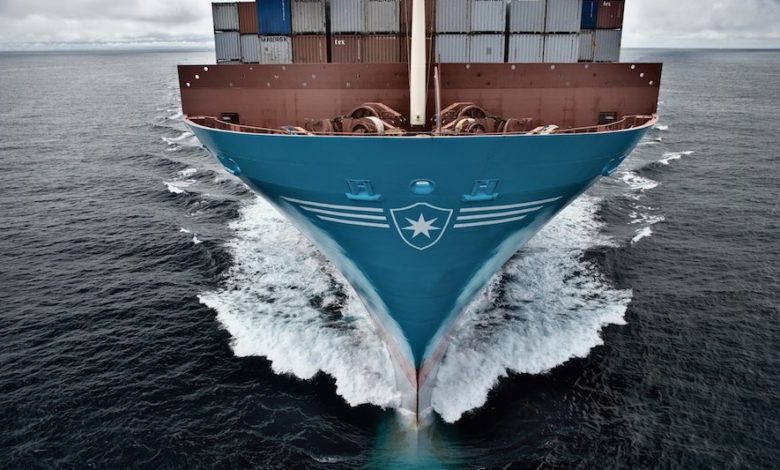Maersk will operate the world’s first carbon neutral containership by 2023 in big methanol breakthrough

Maersk today officially fast-tracked its decarbonisation plans, with a methanol-fuelled 2,000 teu feeder vessel set to be ordered this year to begin operating in 2023. The world’s largest container line also said today that all future Maersk owned newbuildings will have dual fuel technology installed.
“A.P. Moller – Maersk’s ambition is to lead the way in decarbonising global logistics. Our customers expect us to help them decarbonise their global supply chains, and we are embracing the challenge, working on solving the practical, technical and safety challenges inherent in the carbon neutral fuels we need in the future. Our ambition to have a carbon neutral fleet by 2050 was a moonshot when we announced in 2018. Today we see it as a challenging, yet achievable target to reach,” said Søren Skou, CEO of A.P. Moller – Maersk.
Around half of Maersk’s 200 largest customers have set – or are in the process of setting – ambitious science-based or zero carbon targets for their supply chains, and the figure is on the rise.
Maersk’s methanol feeder vessel will be deployed in one of its intra-regional networks, likely Europe. While the vessel will be able to operate on standard VLSFO, the plan is to operate the vessel on carbon neutral e-methanol or sustainable bio-methanol from day one.
It will be a significant challenge to source an adequate supply of carbon neutral methanol within our timeline to pioneer this technology
“It will be a significant challenge to source an adequate supply of carbon neutral methanol within our timeline to pioneer this technology. Our success relies on customers embracing this groundbreaking product and strengthened collaboration with fuel manufacturers, technology partners and developers to ramp up production fast enough. We believe our aspiration to put the world’s first carbon neutral liner vessel in operation by 2023 is the best way to kick start the rapid scaling of carbon neutral fuels we will need,” said Henriette Hallberg Thygesen, CEO of fleet and strategic brands, A.P. Moller – Maersk.
Both the methanol-fueled feeder vessel and the decision to install dual fuel engines on future newbuildings are part of Maersk’s ongoing fleet replacement.
Details of exactly where and when the groundbreaking ship will be built have yet to be made public. A spokesperson for Maersk told Splash today: “The concept design is finalised and we are currently in discussions with equipment suppliers and yards. It is crucial to find the right partners who are ready to engage development resources into such a step change of the industry.”
Maersk reiterated today that it sees methanol, alcohol-lignin blends and ammonia as shipping’s primary fuel candidates for the future.
Some of the biggest names across the Danish transport spectrum including Maersk joined forces last year to produce renewable methanol. Maersk, Copenhagen Airports, DSV Panalpina, roro operator DFDS, airline SAS and utility firm Ørsted have partnered to develop an industrial-scale production facility to produce sustainable fuels including renewable methanol for Maersk vessels. The renewable methanol pathway identified by Maersk is promising, the carrier stated in a release in 2019, because it is liquid at normal temperature and there are existing markets, known execution and infrastructure which can be extended. It is also not a highly toxic product.
The Methanol Institute, which advocates for the adoption of methanol as a fuel in marine and other transport modes, welcomed today’s feeder ship breakthrough news.
Chris Chatterton, COO of the Methanol Institute, said: “Maersk is once again showing industry leadership in adopting renewable methanol as a key plank in its strategy towards carbon neutrality.”
We need industry leaders like Maersk to share research and learnings
Speaking in a January episode of the Outrage and Optimism podcast, which focused on the future of shipping, Skou first revealed Maersk’s plans to order carbon neutral ships within the next three years, starting off with smaller tonnage ships aimed at regional trades, before taking the knowledge and experience from this landmark first generation of new ships to order a round of larger boxships.
Maersk has eschewed new orders lately and has avoided going down the LNG-fuelled path of many of its rivals.
In December 2018, Maersk came out as the first major shipping line to pledge to be carbon neutral by 2050.
In July 2020, A.P. Moller – Maersk together with other large companies such as Nike, Microsoft, Starbucks, Danone and Mercedez-Benz entered the climate coalition Transform to Net Zero, which aims to deliver guidance and business plans to enable a transformation to net zero emissions, as well as research, advocacy, and best practices to make it easier for the private sector to not only set ambitious goals—but also deliver meaningful emissions reductions and economic success
Earlier this month the coalition put out a position paper for priorities for this year and in the decades to come.
The paper noted that members would work in 2021 to pilot the end-to-end decarbonisation of value chains, developing a roadmap for company action to achieve a “just and inclusive” net zero transformation.
“The industry has come together to work on the decarbonisation issue, which requires collaboration across the value chain – from the fuel suppliers to the classification societies to the ports and shipowners,” Andrew Stephens, the executive director of the Sustainable Shipping Initiative, told Splash last month.
“First movers are an essential part of this chain, investing into R&D for sustainable zero carbon fuels and setting their ambitions above what is expected and leading the way. We need industry leaders like Maersk to share research and learnings to enable and accelerate the industry’s transition to zero emissions,” Stephens said.
